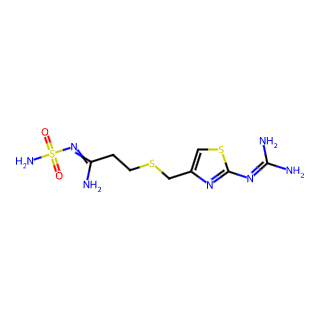- Synthetic anti-infective drugs
- Medications for the digestive system
- Antipyretic and analgesic drugs
- Medications for the blood system
- Medications for the respiratory system
- Anti-allergic drugs
- Medications for the urinary system
- Diagnostic medications
- Immunosuppressive and immunomodulatory drugs
- Vitamins and mineral supplements
- Antioxidants and medications for osteoporosis
- Antiparasitic drugs
- Ophthalmic medications
- Amino acids and their derivatives
- Dermatological medications
- Medications for the circulatory system
- Antitumor drugs
- Medications for the nervous system
- Hormonal and endocrine function-regulating drugs
- Antibiotics
- Others
CAS NO.: 76824-35-6




Famotidine
Famotidine, also known as Pepcid, is an H2 receptor antagonist primarily used in the treatment of conditions associated with excess stomach acid production. Here's a detailed overview of Famotidine:
Basic Information
English Name: Famotidine
Chemical Formula: C8H15N7O2S3
Molecular Weight: 337.445 g/mol
CAS Registry Number: 76824-35-6
Appearance: White crystalline powder
Solubility: Slightly soluble in methanol, very slightly soluble in acetone, practically insoluble in water or chloroform, freely soluble in glacial acetic acid
Pharmacological Action
Famotidine is an H2 receptor antagonist that significantly inhibits gastric acid secretion. Its potency is over 30 times greater than cimetidine and 6-10 times stronger than ranitidine. It works by blocking the H2 receptors on the parietal cells of the stomach, thereby reducing gastric acid production and alleviating symptoms associated with excess acidity.
Indications
Famotidine is indicated for various conditions related to excessive stomach acid, including:
Peptic ulcer disease (gastric and duodenal ulcers)
Stress-induced gastritis
Acute gastric mucosal bleeding
Zollinger-Ellison syndrome (gastrinoma)
Reflux esophagitis
Adverse Reactions
Common adverse reactions to Famotidine include headache, dizziness, constipation, diarrhea, and, rarely, skin rashes or hives due to allergies. However, these symptoms usually resolve after discontinuation of the medication. Overdosage requires prompt gastric lavage and administration of activated charcoal to adsorb and induce bowel movements.
Precautions
Use with caution in patients with impaired hepatic or renal function, and adjust the dosage accordingly.
Famotidine is contraindicated in pregnant and lactating women.
Avoid concomitant use with medications or foods that increase gastric acid production.
Do not combine Famotidine with other antacids or acid-reducing agents.
Keep out of the reach of children.
Drug Interactions
Famotidine does not inhibit hepatic drug-metabolizing enzymes and has minimal drug interactions. However, it mildly affects the metabolism of theophylline, phenytoin, warfarin, nifedipine, and diazepam. Additionally, concurrent use with tetracyclines or fluoroquinolones may reduce their absorption, and with vitamin D analogs, it may increase the risk of hypercalcemia.

Tai Yau Street, San Po Kong, Kowloon, Hong Kong, China.



